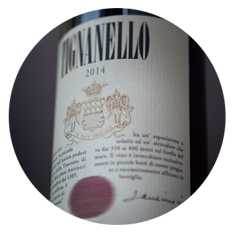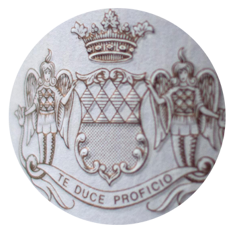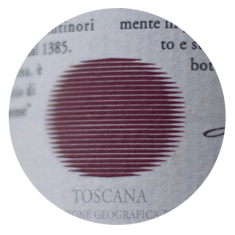Tignanello

The Wine
Tignanello was the first Sangiovese to be aged in barriques, the first contemporary red wine blended with untraditional varieties (specifically Cabernet) and one of the first red wines in the Chianti Classico region that didn’t use white grapes. Tignanello is a milestone. It’s produced with a selection of Sangiovese, Cabernet Sauvignon and Cabernet Franc.
Historical Data
Tignanello is produced exclusively from the vineyard of the same name, a parcel of some 190 acres (77 hectares) with limestone-rich soils and a southwestern exposure at 1150-1325 feets (350-400 meters) above sea level at the Tignanello estate. It was the first Sangiovese wine to be aged in small oak barrels, the first modern red wine to use such non-traditional varieties as Cabernet in the blend, and among the first red wines from the Chianti Classico area to be produced without white grapes. The wine, originally called "Chianti Classico Riserva Vigneto Tignanello" (a Chianti Classico Riserva from the Tignanello vineyard), was produced for the first time from a single vineyard parcel in 1970, when the blend contained 20% of Canaiolo and 5% of Trebbiano and Malvasia, both white grapes, and the wine aged in small oak barrels. In 1971 it became a Tuscan red table wine rather than a Chianti Classico, and was called Tignanello. In the 1975 vintage the percentage of white grapes was definitively eliminated from the blend. Ever since 1982, the blend has been the one currently used. Tignanello is bottled only in favorable vintages, and was not produced in 1972, 1973,1974, 1976, 1984, 1992, and 2002.
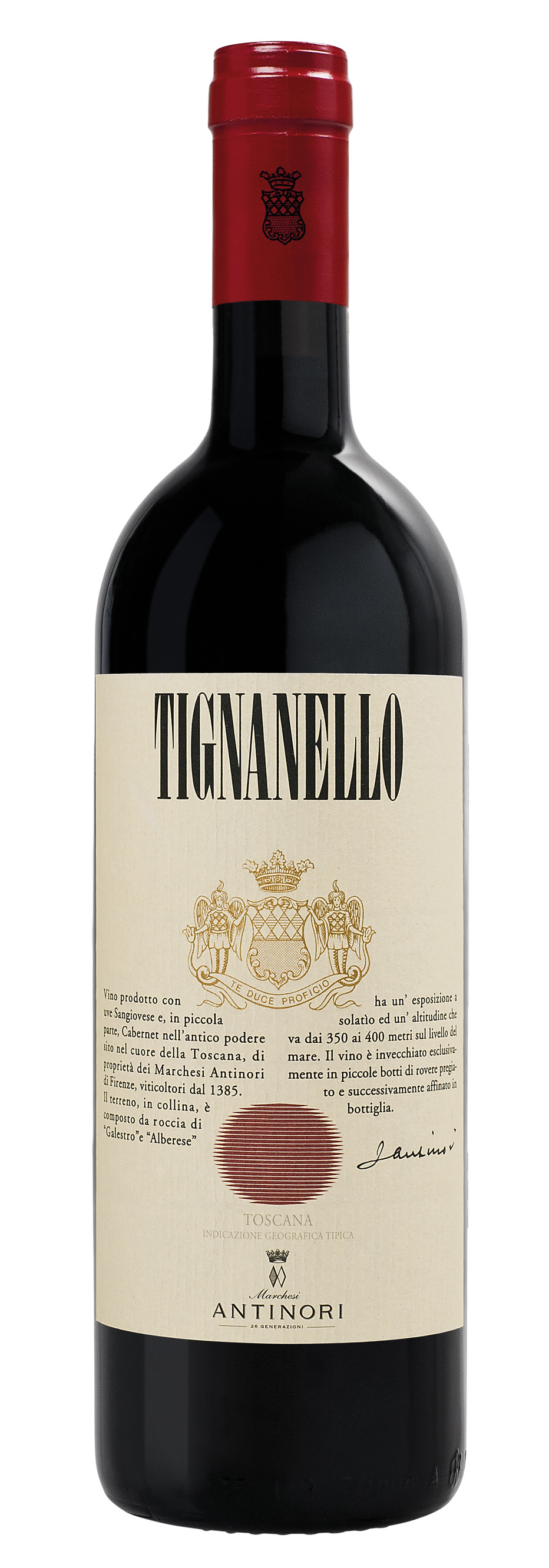
The Wine
Tignanello was the first Sangiovese to be aged in barriques, the first contemporary red wine blended with untraditional varieties (specifically Cabernet) and one of the first red wines in the Chianti Classico region that didn’t use white grapes. Tignanello is a milestone. It’s produced with a selection of Sangiovese, Cabernet Sauvignon and Cabernet Franc.

The Design
The label was designed by Silvio Coppola in 1974 for the release of Tignanello 1971. The idea to commission this artist was discussed at an event at Castello della Sala in 1973. Silvio Coppola was an important Italian graphic and interior designer who was famous for his minimalist lighting fixtures and austere furniture but also for book cover designs for Italian publishing company Feltrinelli. Silvio Coppola was the perfect match for the job.
The Signature
Marchese Piero Antinori, the current Honorary President, decided to have his father, Niccolò Antinori, sign the label as a sign of recognition for his father’s confidence in him.
Te Duce Proficio
The historic family crest of the Antinori family
The Sun
Tignanello’s stylized “Sun” by Silvio Coppola
Climate
After a fall and winter characterized by mild temperatures and frequent rainfall, spring began with similar weather, which determined a slight delay first in bud break and then in the following phases of flowering and bud set. The months of May and June were a bit cooler than the historic averages, while July and August were quite warm and dry, but without excessively hot peak temperatures. The month of September and the first half of October, the period of the harvest, were climatically ideal - in addition to warm daytime temperatures, there were significant temperature swings from daytime warmth to evening and nighttime coolness which assisted the grapes in achieving excellent ripeness. Picking operations, generally later than in recent vintages, began during the second half of September, first with the Sangiovese around September 25th and then with the Cabernet Franc between September 29th and 30th. The Cabernet Sauvignon, finally, was harvested between October 5th and 15th under perfect climatic conditions for the quality of the fruit.
Vinification
The climate of the growing season required an intense and careful selection of the grapes both in the vineyard and in the cellars. This rigorous selection assisted in giving an additional quality level to the grapes to be used for Tignanello which, already exceptional in terms of both their typicality and personality, regularly give wines of outstanding character and structure. Extreme care was given to the freshness of the aromas and to the extraction of color and tannins aimed at the maximum suppleness and elegance during the period of fermentation and skin contact in conical fermenting tanks. Once the wine was run off its skins, it was put through a complete malolactic fermentation in oak barrels in order to heighten to the maximum degree the finesse and the fragrance of the aromas. The twelve to fourteen months aging period then began and took place in French and Hungarian oak barrels, partly new and partly used once previously. During this phase, the various lots, fermented variety by variety, completed the aging process and were then assembled to create the finished wine just a few months before bottling.
Historical Data
Tignanello is produced exclusively from the vineyard of the same name, a parcel of some 190 acres (77 hectares) with limestone-rich soils and a southwestern exposure at 1150-1325 feets (350-400 meters) above sea level at the Tignanello estate. It was the first Sangiovese wine to be aged in small oak barrels, the first modern red wine to use such non-traditional varieties as Cabernet in the blend, and among the first red wines from the Chianti Classico area to be produced without white grapes. The wine, originally called "Chianti Classico Riserva Vigneto Tignanello" (a Chianti Classico Riserva from the Tignanello vineyard), was produced for the first time from a single vineyard parcel in 1970, when the blend contained 20% of Canaiolo and 5% of Trebbiano and Malvasia, both white grapes, and the wine aged in small oak barrels. In 1971 it became a Tuscan red table wine rather than a Chianti Classico, and was called Tignanello. In the 1975 vintage the percentage of white grapes was definitively eliminated from the blend. Ever since 1982, the blend has been the one currently used. Tignanello is bottled only in favorable vintages, and was not produced in 1972, 1973,1974, 1976, 1984, 1992, and 2002.
Tasting Notes
An intense ruby red in color with purple highlights, the 2013 Tignanello shows a nose of great red fruit intensity along with highly pleasurable notes of vanilla, chocolate, and leather from the well balanced contribution and fusion of the aromas of the oak. The spicy and balsamic sensations which give additional complexity are also quite important. The wine is ample and enveloping on the palate with supple tannins and a savory freshness which fully respects the character and personality of the Sangiovese grape. The balance between acidity and tannins is excellent, and the finish and aftertaste are of a lovely length and persistence.
Awards
James Suckling 97/100 Wine Advocate 96/100
Scheda
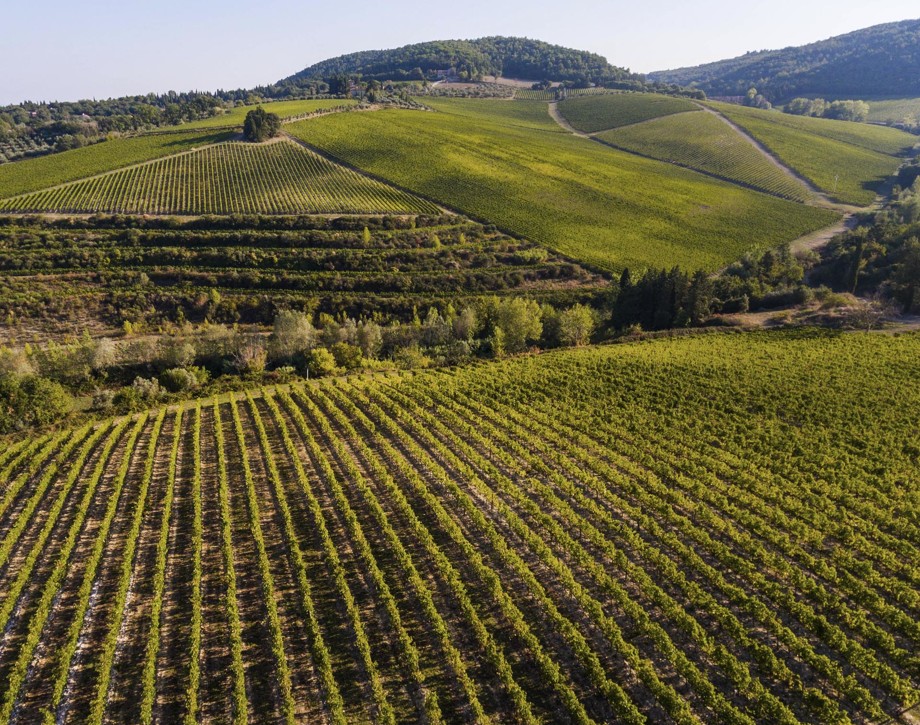
Tenuta Tignanello
The Tenuta Tignanello estate is in the heart of Chianti Classico, in the gently rolling hillsides between the Greve and Pesa river valleys. It extends over an area of 319 hectares (788 acres), of which about 165 (407 acres) are dedicated to vines. Two of the estate’s prized vineyards are on the same hillside, Tignanello and Solaia, on soils that originated from marine marlstone from the Pliocene period rich in limestone and schist. The vines enjoy hot temperatures during the day and cooler evenings throughout the growing season. The estate’s two signature wines, Solaia and Tignanello, are produced from these vineyards and have been defined by the international press as “among the most influential wines in the history of Italian viticulture”. According to Marchesi Antinori, Solaia and Tignanello are an ongoing challenge and a never-ending passion. The Tignanello estate has vineyards of indigenous Sangiovese grapes as well as some other untraditional varieties such as Cabernet Franc.
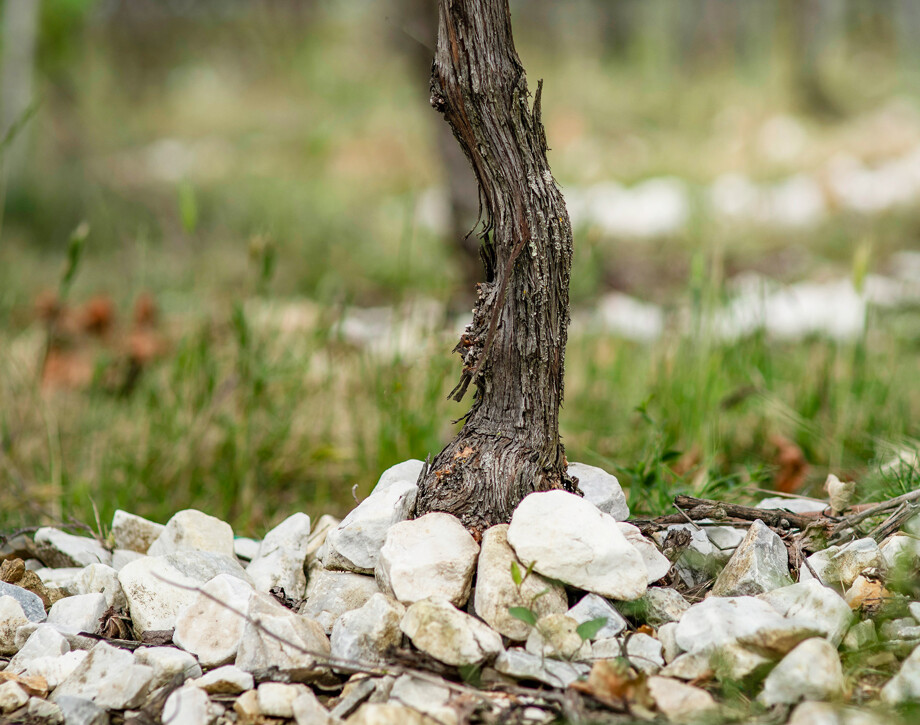
Soil
Calcareous rocky soils with alberese (marl limestone) and marl.
